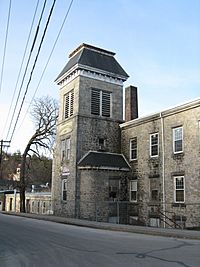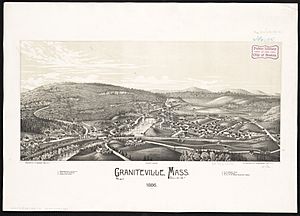Graniteville Historic District (Westford, Massachusetts) facts for kids
Quick facts for kids |
|
|
Graniteville Historic District
|
|

C.G. Sargent's Sons 1877
|
|
| Location | Westford, Massachusetts |
|---|---|
| Area | 150 acres (61 ha) |
| Architect | Woodcock, S.S.; et al. |
| Architectural style | Federal, Gothic |
| NRHP reference No. | 01001467 |
| Added to NRHP | January 17, 2002 |
The Graniteville Historic District is a special area in Westford, Massachusetts. It's like a time capsule, showing how a busy industrial village looked in the 1800s. This district is famous for its old granite quarries and the factories that grew up around them.
Contents
Discovering Graniteville's Past
Graniteville was once a small place, mostly known for its rich granite quarries. People dug out large blocks of stone here. This stone was used to build many things, like buildings and bridges. The area started to change a lot in 1847.
The Arrival of the Railroad
In 1847, something big happened: the railroad arrived! This made it much easier to transport heavy granite and other goods. The railroad's arrival helped Graniteville grow quickly. It connected the village to bigger towns and cities.
From Quarries to Mills
After the railroad came, a man named Charles G. Sargent built a factory, also called an industrial mill. This mill helped turn raw materials into finished products. The new factory brought more jobs and people to Graniteville. The village quickly became a busy center for industry.
Homes and Buildings
As the area grew, many homes were built for the workers and their families. Important public buildings were also constructed. These included places like schools, churches, and town halls. Most of these buildings were built in the second half of the 1800s. They show us what life was like back then.

What Makes it Historic?
The Graniteville Historic District is important because it shows us a piece of history. It tells the story of how a small quarry town became a thriving industrial village. The district includes many old buildings and quarry sites. These places help us understand the past.
The district's boundaries are carefully set. On the east, it's bordered by River Street. To the south, it's bordered by Bridge Street and North Main Street. The western edge goes past North Main Street's meeting with West Street. It then goes north and east to include several old quarry sites. Finally, it meets North Main Street at River Street.
The Graniteville Historic District was officially recognized in 2002. It was added to the National Register of Historic Places. This list includes places that are important to the history of the United States.



